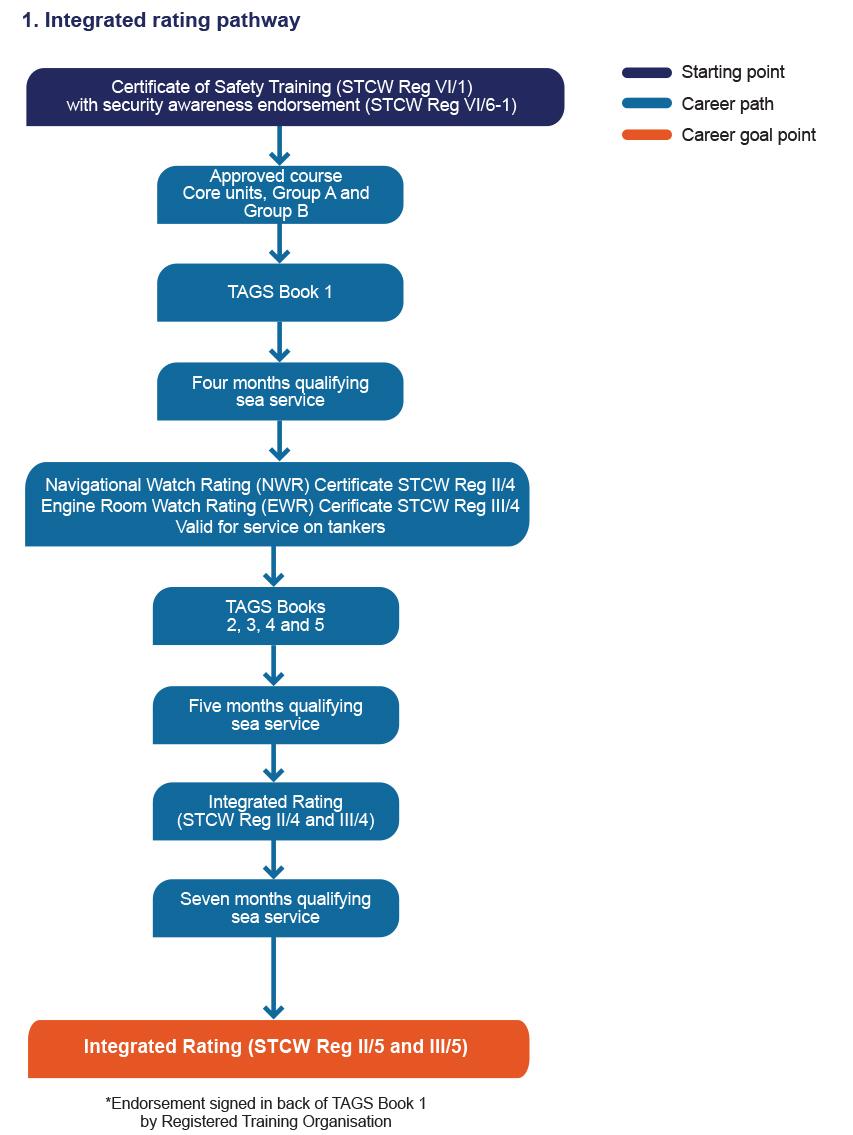Career pathways for ratings
'Ratings' refers to skilled seafarers who perform various essential tasks across all ship departments.
There are several pathways you can take to become a rating. It depends on the area you decide to work in.
STCW refers to The International Convention on Standards of Training, Certification and Watchkeeping for Seafarers 1978.
You can hold any of the following:
- Navigational watch rating certificate (STCW Reg II/4)
- Engine room watch rating certificate (STCW Reg III/4)
- Certificate of proficiency as integrated rating (STCW Reg II/4 and Reg III/4)
- Certificate of proficiency as integrated rating (STCW Reg II/5 and Reg III/5)
- Certificate of proficiency as chief integrated rating (STCW Reg II/5 and Reg III/5)
- Certificate of proficiency as able seafarer—deck (STCW Reg II/5)
- Certificate of proficiency as able seafarer—engine (STCW Reg III/5)
More information
Ratings training requirements
- Trainee requirements per ratings task
Ratings task Requirement Navigational watch and engine room watch ratings (see schedule 1) two months qualifying sea service an AMSA Certificate of safety training (STCW Reg VI/1) with security awareness endorsement (STCW Reg VI/6-1)
and
must also complete approved shore based training before joining their first ship (see schedule 1).
six months of qualifying sea service and
a valid Certificate of medical fitness form 303
Integrated ratings (international qualification for Australian registered vessels operating in international waters) AMSA Certificate of safety training
and
a valid Certificate of medical fitness form 303
and
completion of Certificate III in Maritime Operations (Integrated Rating) shore-based training program.
- Pre-sea—Certificate of safety training
The Certificate of safety training (COST) is the first international qualification you need to become a seafarer.
Unit number Competency STCW reference MARF037 Follow vessel security procedures (security awareness training) STCW Code table A-VI/6-1 MARF041 Observe personal safety and social responsibility (PSSR) STCW Code table A-VI/1-4 MARF035 Contribute to fire prevention and firefighting (basic firefighting) STCW Code table A-VI/1-2 MARF046 Survive at sea in the event of vessel abandonment and personal survival techniques (PST) STCW Code table A-VI/1-1 HLTAID011 Provide first aid STCW Code table A-VI/1-3 Learn more about the Certificate of safety training.
- Certificate III in Maritime Operations (Integrated Rating)
You must complete an AMSA approved training program that meets the requirements of STCW.
The approved training program is the Certificate III in Maritime Operations (Integrated Rating).
It comprises:
- 27 units of competency
- 5 tasks and guided study books (TAGS books)
- qualifying sea service.
The units of competency are separate sections or courses, named pre-sea (Certificate of Safety training).
They include:
- 17 core units of competency common to both deck and engine room ratings
- 7 deck rating requirements (Group A)
- 3 engine rating requirements (Group B)
Find out more about Certificate III in maritime operations (integrated rating) and the units of competency at training.gov.au.
- Task and guided study (TAGS) books
The approved TAGS books include:
- TAGS book 1—Shipboard induction, shipboard procedures, engine room duties, work health and safety/occupational health and safety requirements
TAGS Book 1 is available as two separate volumes.
- Suitable for trainees getting a Navigational watch rating certificate.
- Suitable for trainees getting an Engine watch rating certificate.
- TAGS book 2—Survival management, survival craft, firefighting and prevention
- TAGS book 3—Engine room, deck machinery
- TAGS book 4—Ships maintenance and marine rigging
- TAGS book 5—Dry cargo, liquid cargo, offshore vessels
After four months qualifying sea service and completion of TAGS book 1, you may receive STCW Regulation II/4 – ratings assisting in keeping a navigation watch and STCW Regulation III/4 – ratings assisting in keeping in an engine room watch.
Pathways to enter the industry as a rating
- 1. Integrated rating pathway
